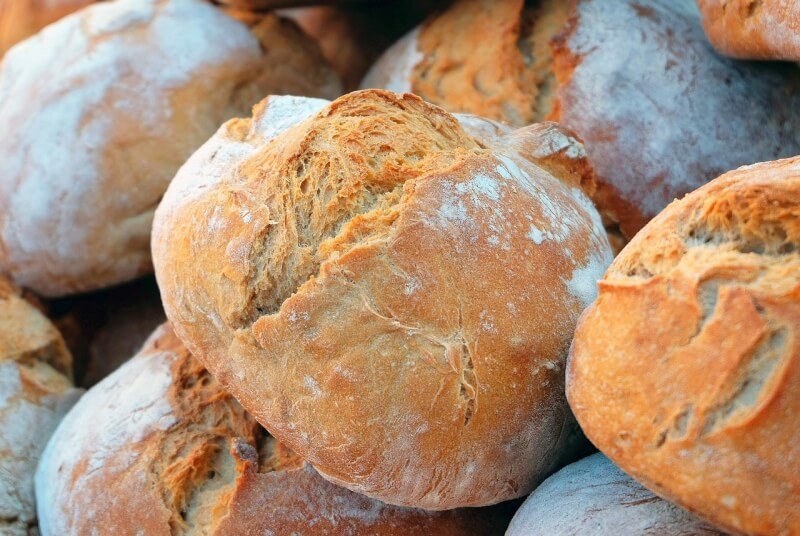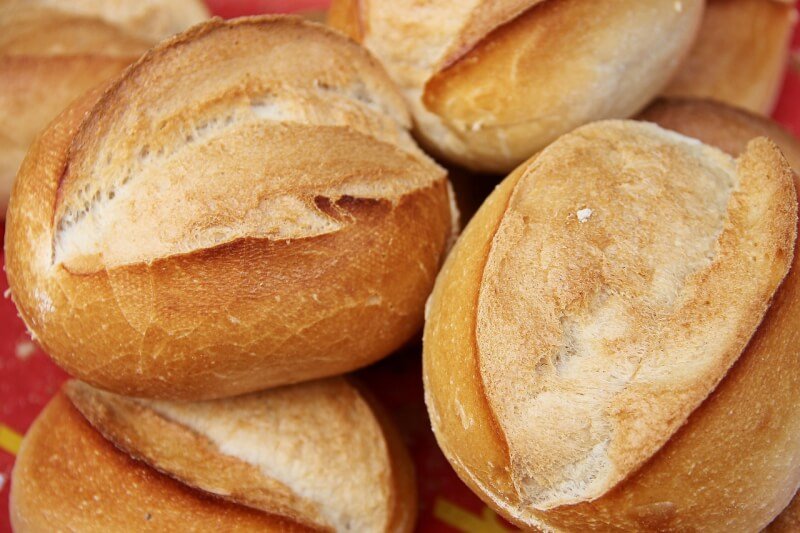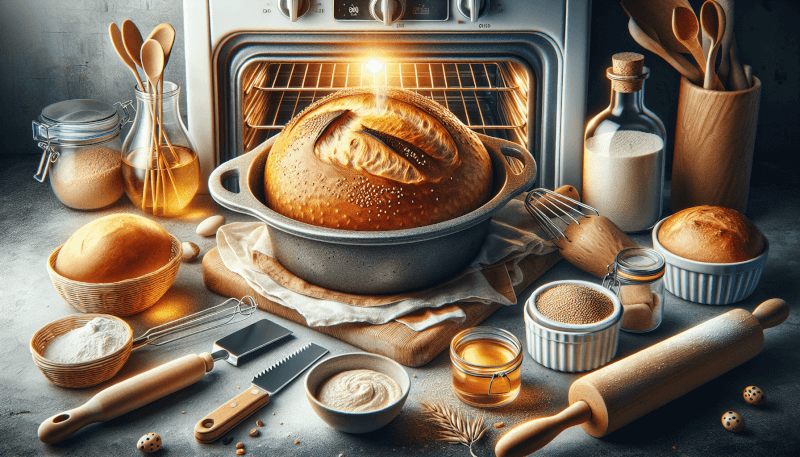If you’ve ever dreamed of filling your home with the warm, comforting aroma of freshly baked bread, then this article is for you. We’ve gathered the top 10 bread baking essentials that every home baker needs to have in their kitchen. From the perfect mixing bowl to the essential dough scraper, we’ll guide you through the must-have tools that will elevate your bread baking game and have you creating delicious loaves in no time. So, grab your apron and get ready to become a master bread baker in the comfort of your own home!
1. High-Quality Bread Flour
Understanding different types of flour
When it comes to baking bread, choosing the right flour is crucial. Understanding the different types of flour available will help you make an informed decision. All-purpose flour is a versatile option, but for a truly high-quality loaf, bread flour is recommended. This type of flour has a higher protein content, which gives bread its structure and chewiness. Other types of flour, such as whole wheat flour or rye flour, can also be used for different flavor profiles and textures.
Choosing the right flour for bread baking
For the best results in bread baking, it is important to choose a high-quality bread flour. Look for flour that is specifically labeled as “bread flour” or “high-protein flour” to ensure you are getting the right type. It should have a protein content of around 12-14%. This higher protein content helps create the strong gluten network necessary for a good rise and a chewy texture. It is also important to consider the brand and reputation of the flour. Some recommended brands of bread flour include King Arthur Flour, Bob’s Red Mill, and Gold Medal.
Recommended brands of bread flour
- King Arthur Flour: Known for its high quality and consistency, King Arthur Flour is a popular choice among professional and home bakers alike. Their bread flour is made from hard red spring wheat and has a protein content of 12.7%.
- Bob’s Red Mill: Another trusted brand in the baking world, Bob’s Red Mill offers a wide range of flours, including bread flour. Their bread flour has a protein content of 12.5% and is milled from hard red spring wheat.
- Gold Medal: Gold Medal is a well-known brand that has been producing flour for over 135 years. Their bread flour is made from hard red spring wheat and has a protein content of 12.7%.
2. Active Dry Yeast
The role of yeast in bread baking
Yeast is an essential ingredient in bread baking as it is responsible for the fermentation process that allows the dough to rise. Yeast is a living organism that consumes sugars in the dough and produces carbon dioxide gas, causing the dough to expand. This fermentation process creates the airy and light texture we associate with bread.
How to activate and use active dry yeast
Active dry yeast is a common form of yeast used in bread baking. To activate it, dissolve the yeast in warm water with a small amount of sugar. The warm water helps wake up the yeast and the sugar acts as food to activate it. After a few minutes, the yeast should be frothy, indicating that it is active and ready to use. It is important to note that if the yeast does not froth or bubble, it may be expired or dead and will need to be replaced.
When using active dry yeast in a bread recipe, it should be added to the dry ingredients before mixing in the liquid. This allows the yeast to fully hydrate and activate during the mixing process. Follow the instructions in your specific recipe for the amount of yeast to use, as it can vary depending on the recipe and desired rise time.
Recommended brands of active dry yeast
- Fleischmann’s: Fleischmann’s is a well-known brand that has been producing yeast for over 150 years. Their active dry yeast is reliable and widely available, making it a popular choice among home bakers.
- Red Star: Red Star offers a range of yeast products, including active dry yeast. Their yeast is known for its consistent performance and is a trusted choice for many bakers.
- SAF: SAF is a brand favored by professional bakers for its high-quality yeast. Their active dry yeast is known for its strength and reliability, making it a great choice for those looking to achieve consistent results in their bread baking.

3. Kitchen Scale
The importance of precision in bread baking
Bread baking is a science that requires precision. Measuring ingredients accurately is crucial to ensure the right balance of flavors and textures in your bread. Using a kitchen scale instead of relying on volume measurements, such as cups or tablespoons, allows for a more precise and consistent result.
Measuring ingredients accurately with a kitchen scale
A kitchen scale is a must-have tool for any serious bread baker. It allows you to measure ingredients by weight, which is much more accurate than using volume measurements. Different flours, for example, can vary greatly in density, so using weight measurements ensures that you are adding the correct amount of flour to your dough.
When using a kitchen scale, place your bowl or container on the scale and zero out the weight. Then, add the ingredient you want to measure until you reach the desired weight. This method ensures that you are using the exact amount of each ingredient, resulting in consistent and reliable recipes.
Recommended kitchen scale options
OXO Good Grips Stainless Steel Food Scale: This scale features a sleek design and a capacity of up to 11 pounds. It has an easy-to-read display and a zero function for measuring ingredients in a container. It also has a removable stainless steel platform for easy cleaning.
Escali Primo Digital Kitchen Scale: The Escali Primo scale is a compact and affordable option. It has a capacity of up to 11 pounds and features a simple two-button operation. The scale also has a tare function and an automatic shut-off feature to conserve battery life.
My Weigh KD-8000 Kitchen Scale: The My Weigh KD-8000 scale is a high-quality option with a capacity of up to 17.6 pounds. It has a backlit display for easy reading and includes a removable protective cover that can double as a weighing tray. The scale also has advanced features such as percentage weighing and calorie calculations.
4. Dough Scraper
Benefits of using a dough scraper
A dough scraper, also known as a bench scraper, is a versatile tool that every bread baker should have. It is primarily used to scrape sticky dough off work surfaces, but it also has many other useful functions.
One of the key benefits of using a dough scraper is that it helps keep your work area clean and free from sticky dough residue. It allows you to easily gather up any loose bits of dough and transfer them to your bowl or work surface. This not only saves time but also helps to maintain a tidy and organized workspace.
Various ways to utilize a dough scraper in bread making
In addition to its primary use of scraping dough, a dough scraper can be used for shaping and dividing dough. It can be used to cut the dough into equal portions when making rolls or individual loaves. It can also be used to shape and smooth the dough by gently pushing and folding it with the scraper.
Furthermore, a dough scraper can be handy for cleaning leftover dough from bowls and other utensils. Its flat edge is perfect for scraping dough off the sides of mixing bowls or measuring cups.
Recommended dough scraper options
OXO Good Grips Stainless Steel Dough Scraper: This dough scraper features a comfortable non-slip handle and a stainless steel blade. It has inch and centimeter measurements on the blade, making it useful for dividing dough accurately. The blade is sharp enough to cut through dough but not too sharp to cause accidental cuts.
Bench Knife and Dough Scraper by Kaizen Cutlery: This dough scraper is made from high-quality stainless steel and has a wooden handle for a comfortable grip. The blade is sharp and durable, making it ideal for scraping sticky dough off surfaces. It is also easy to clean and dishwasher safe.
Lamson Dough Scraper: The Lamson dough scraper is made in the USA and features a stainless steel blade with a beveled edge for easy scraping. The handle is made from a durable resin material and provides a comfortable grip. This dough scraper is built to last and can withstand heavy use.

5. Bread Proofing Basket
Understanding the purpose of a bread proofing basket
A bread proofing basket, also known as a banneton or brotform, is a specially designed basket that helps shape and support the dough during the final rise. It is usually made from natural materials, such as rattan or cane, and has a decorative pattern that leaves a beautiful imprint on the bread.
The purpose of a bread proofing basket is to support the dough during the final rise, preventing it from spreading out too much and maintaining its shape. The basket also helps to absorb excess moisture from the dough, creating a slightly drier surface that promotes a better crust formation during baking.
How to use a proofing basket effectively
To use a bread proofing basket, start by lightly dusting it with flour. This prevents the dough from sticking to the basket during the final rise. Gently shape your dough into a round or oblong shape and place it seam-side up in the basket. Cover the dough with a clean cloth or plastic wrap and let it rise until doubled in size.
When it is time to bake, carefully invert the basket onto a parchment-lined baking sheet or peel, allowing the dough to gently release from the basket. Slash the top of the dough with a bread lame or a sharp knife, and then transfer it to the oven for baking.
Recommended bread proofing basket options
Bread Bosses 10-inch Round Banneton Proofing Basket: This round banneton proofing basket is made from high-quality rattan cane and has a smooth surface that prevents sticking. It is durable and easy to clean, making it a reliable choice for bread baking.
BrotformDotCom 9-inch Oval Banneton Proofing Basket: This oval banneton proofing basket is made from natural rattan cane and features a decorative spiral pattern. It is sturdy and provides excellent support for the dough during the final rise.
Breadtopia 8.5-inch Round Banneton Proofing Basket: This round banneton proofing basket is made from unbleached rattan cane and has a linen liner for easier dough release. It is handcrafted and made to last, ensuring consistent results in your bread baking.
6. Bread Lame
What is a bread lame and its importance
A bread lame is a small tool used to score the surface of bread dough just before baking. It consists of a handle and a razor blade, which allows bakers to create precise cuts on the dough’s surface. Scoring the dough serves multiple purposes, including controlling the direction of the bread’s expansion and creating an attractive pattern.
The importance of a bread lame lies in its ability to control the rise and shape of the bread during baking. By scoring the dough, you create weak points where the bread can expand and rise in a controlled manner. This helps prevent the bread from bursting or cracking in undesirable places.
Scoring techniques and styles using a bread lame
There are various scoring techniques and styles that can be achieved using a bread lame. Some common techniques include the straight slash, the crescent, and the diamond pattern. The straight slash involves making a series of parallel, diagonal cuts on the surface of the dough. The crescent technique creates a half-moon shape by making curved cuts. The diamond pattern involves creating intersecting slashes to form a diamond-like shape.
When scoring the dough, it is important to hold the lame at a slight angle to allow the blade to cut through the surface easily. A confident and swift motion will help create clean cuts without dragging or tearing the dough.
Recommended bread lame options
BREAD STORY Bread Lame: This bread lame features a sleek design with a comfortable wooden handle and a replaceable stainless steel blade. The blade is curved, allowing for a better grip and control during scoring. It also comes with a protective case for safe storage.
Tinkering Supplies Bread Lame: This bread lame has an ergonomic design with a stainless steel handle and a curved blade. The blade is sharp and can be rotated or replaced for longevity. It comes with a leather sheath for safe storage and protection.
King Arthur Baking Bread Lame: This bread lame has a simple yet effective design with a wooden handle and a replaceable stainless steel blade. The blade is curved and sharp, making it easy to achieve clean and precise cuts on the dough. It also comes with a blade storage case for safety.

7. Dutch Oven
The benefits of baking bread in a Dutch oven
Baking bread in a Dutch oven has several benefits that contribute to a successful loaf. The enclosed space created by the Dutch oven traps steam, which helps create a moist environment for the dough to rise. This steam also promotes a beautiful crust formation, resulting in a crispy exterior and a tender interior.
The Dutch oven’s thick walls and even heat distribution help maintain a consistent temperature throughout the baking process. This allows the bread to bake evenly and develop a uniform color and texture. The lid of the Dutch oven also helps retain moisture in the bread, preventing it from drying out during baking.
Choosing the right size and material for a Dutch oven
When choosing a Dutch oven for bread baking, consider both the size and material. The size of the Dutch oven should be large enough to accommodate the size of your bread dough while leaving enough space for it to rise and expand. A 5- or 6-quart Dutch oven is generally suitable for most bread recipes.
In terms of material, enameled cast iron is a popular choice for Dutch ovens due to its excellent heat retention and even heat distribution. The enamel coating also prevents the dough from sticking to the surface, making it easier to release the bread after baking. Other materials, such as stainless steel or ceramic, can also be used but may require adjustments to baking times and temperatures.
Recommended Dutch oven options
Lodge Enameled Cast Iron Dutch Oven: This Dutch oven is made from durable cast iron with an enamel coating. It is available in various sizes and colors to suit different needs and preferences. The lid has a secure fit to trap steam and retain moisture during baking.
Le Creuset Signature Enameled Cast Iron Dutch Oven: Le Creuset is known for its high-quality cookware, and their Dutch oven is no exception. Made from enameled cast iron, this Dutch oven offers excellent heat retention and even heat distribution. It is available in a range of sizes and colors to suit different baking needs.
Cuisinart Chef’s Classic Enameled Cast Iron Dutch Oven: This Dutch oven features an enamel-coated cast iron construction for superior heat retention and even heat distribution. It has a tight-fitting lid and loop handles for easy maneuverability. The oven-safe knob on the lid allows for baking at high temperatures.
8. Bread Baking Stone
The purpose and advantages of using a bread baking stone
A bread baking stone, also known as a pizza stone or baking stone, is a thick, flat slab made from natural materials such as ceramic, clay, or stone. It is used to create a more favorable baking environment for bread by absorbing and evenly distributing heat.
The purpose of a bread baking stone is to mimic the intense heat of a brick oven in a home oven. It helps to create a crispier crust by drawing moisture away from the bread dough. Additionally, the stone retains and radiates heat, which promotes a more even rise and better oven spring.
Utilizing a baking stone for better crust and texture
To utilize a bread baking stone effectively, it should be preheated in the oven before baking. This ensures that the stone reaches the desired temperature, allowing for optimal heat transfer to the dough. The hot surface of the stone creates a burst of steam as soon as the dough is placed on it, resulting in better crust formation and a lighter texture.
When using a bread baking stone, it is recommended to place it on the lowest rack in the oven for maximum heat absorption. Preheat the stone for at least 30 minutes before baking to ensure that it reaches the desired temperature.
Recommended bread baking stone options
Old Stone Oven Rectangular Pizza Stone: This pizza stone is made from natural cordierite stone and is designed to withstand high temperatures without cracking. It has a rectangular shape that provides ample surface area for baking bread. The stone is 14″ x 16″ and fits most standard ovens.
Emile Henry Flame Top Pizza Stone: This pizza stone is made from high-quality ceramic that is resistant to chipping and cracking. It is available in a variety of sizes and shapes to suit different baking needs. The stone is designed to evenly distribute heat and is safe for use in conventional and convection ovens.
FibraMent-D Baking Stone: The FibraMent-D baking stone is made from a proprietary blend of heat-resistant materials that allow for even heat distribution. It is ideal for baking artisanal bread and is available in various sizes to fit different oven configurations. The stone is highly durable and requires minimal maintenance.

9. Bread Loaf Pan
Different types of bread loaf pans
Bread loaf pans come in various materials and shapes, each offering different advantages for specific types of bread. Common types of bread loaf pans include metal, glass, and silicone.
Metal loaf pans, typically made from aluminum or steel, are popular for their excellent heat conductivity and durability. Glass loaf pans, on the other hand, offer the advantage of being transparent, allowing you to monitor the browning of your bread as it bakes. Silicone loaf pans are flexible and non-stick, making it easier to release the bread after baking.
Choosing the right loaf pan for your bread
When choosing a bread loaf pan, consider the type of bread you will be baking and your personal preferences. For sandwich bread that requires a crisp crust, a metal loaf pan is recommended as it promotes better browning. Glass loaf pans are great for quick breads or recipes that don’t require a strong crust, as they tend to produce a softer crust. Silicone loaf pans are versatile and can be used for a variety of bread recipes, including yeast breads and quick breads.
Size is also an important consideration when choosing a loaf pan. Most bread recipes specify a specific size, typically 9×5 inches or 8×4 inches. Using the recommended size ensures that the bread bakes evenly and has the desired height and shape.
Recommended bread loaf pan options
USA Pan Bakeware Aluminized Steel Bread Loaf Pan: This bread loaf pan is made from heavy-gauge aluminized steel for superior heat conductivity and durability. It features a non-stick coating that allows for easy release of the bread and effortless cleaning. The pan is available in different sizes to suit your baking needs.
Pyrex Glass Loaf Pan: This glass loaf pan is made from high-quality tempered glass that is safe for use in the oven, microwave, and dishwasher. It has a non-porous surface that resists staining and does not absorb odors. The pan is available in different sizes and shapes, including a traditional rectangular shape and a round shape.
Silicone Bread Loaf Pan: This silicone loaf pan is made from food-grade silicone that is flexible, non-stick, and easy to clean. It is safe for use in the oven, microwave, and freezer. The pan is available in different sizes and colors, and its flexibility allows for easy removal of the baked bread.
10. Bread Slicer
Benefits of using a bread slicer
A bread slicer is a handy tool that provides precision and consistency when slicing bread. It allows you to achieve uniform slices of bread, ensuring that each slice is the same width and thickness. This is particularly useful when making sandwiches or toast, as it creates a visually appealing and evenly portioned end product.
Using a bread slicer also reduces the risk of injury when slicing bread by providing a stable and guided platform for the knife. This can be especially beneficial for those who may have difficulty with manual dexterity or have limited experience with knife skills.
Types of bread slicers and their features
There are different types of bread slicers available on the market, each with its own features and benefits. One common type is a wooden bread slicer, which is made from solid wood and usually has slotted openings for inserting the knife. This type of bread slicer is sturdy and provides good support for the bread.
Another type of bread slicer is an adjustable bread slicer, which allows you to customize the thickness of the slices. These slicers typically have multiple slots or grooves that allow you to choose the desired thickness, ensuring consistent results every time.
Some bread slicers also come with additional features, such as a crumb catcher to keep your countertop clean or a foldable design for compact storage. Consider your specific needs and preferences when choosing a bread slicer.
Recommended bread slicer options
Norpro Bread Slicer: The Norpro bread slicer is made from beautiful and durable acacia wood. It has a classic design with slotted openings for the knife and a crumb catcher to keep your countertop clean. The slicer is adjustable, allowing you to customize the thickness of the slices.
Bambusi Bamboo Bread Slicer: This bread slicer is made from sustainable and eco-friendly bamboo. It has an adjustable design that accommodates various bread sizes and thicknesses. The slicer also features side handles for easy carrying and a crumb catcher tray for easy cleanup.
KitchenCraft Plastic Adjustable Bread Keeper: This bread slicer is made from durable and easy-to-clean plastic. It has an adjustable design that allows you to slice bread of various thicknesses. The slicer also doubles as a bread storage container, keeping your bread fresh for longer.
In conclusion, these top 10 bread baking essentials are must-haves for any home baker looking to elevate their bread making skills. From high-quality bread flour to a bread slicer, each tool plays a unique role in creating the perfect loaf of bread. By understanding the importance of each essential and choosing the right options, you can enhance your bread baking experience and achieve delicious and professional-looking results. Happy baking!



